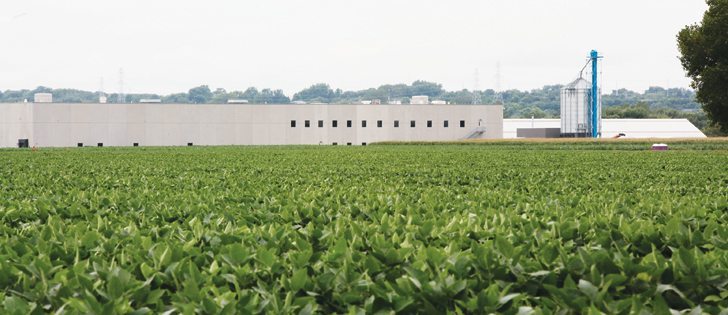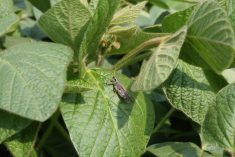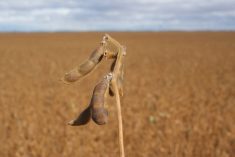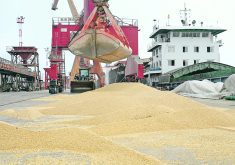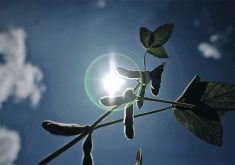Many producers didn’t get the advantage of a bumper crop because they were scared off by last year’s disappointment
Hindsight is always flawless and usually pointless.
Still, Rob Stone would love to turn back the clock and take a bigger risk in May.
“This is one of those years I wish I hadn’t tried 90 acres of soybeans. I wish I had a couple of thousand acres,” said Stone, who farms near Davidson, Sask.
In late August, Stone’s relatively small soybean crop looked tremendous. He said most of the pods had three to four seeds and the crop was flourishing.
“We’ve had adequate to surplus moisture in this area pretty much right through (the growing season). We never experienced any of the drought problems that a lot of areas of Saskatchewan have,” said Stone, who is also a Pioneer Hi-Bred representative.
Read Also

Farming Smarter receives financial boost from Alberta government for potato research
Farming Smarter near Lethbridge got a boost to its research equipment, thanks to the Alberta government’s increase in funding for research associations.
“They look really good.”
Stone has experimented with small acres of soybeans in previous years, including a crop failure in 2014.
“That didn’t work out because of frost and hail at the end of May. They didn’t come out of the ground,” he said.
“This (year) is our first, I’d call, real attempt at a decent (amount) of acres to get an idea of how it’s going to work for us.”
Stone is pleased with the experiment, and many soybean growers in Saskatchewan are likely feeling the same way.
Sherri Roberts, Saskatchewan Agriculture’s regional crops specialist in Weyburn, said soybean fields in southeastern Saskatchewan look promising.
Roberts, who was checking crops near Kendal, Sask., Aug. 26, said most soybean crops in the region were almost a metre tall, had three to four beans per pod and had no disease issues.
“The (soybeans) I’ve looked at, all are looking pretty good,” she said.
“We got our rains on time in 90 percent of the area…. The farmers down here have been pretty lucky.”
This year’s growing season is a marked improvement from last year, when spring rain drowned out hundreds of thousands of acres and delayed seeding in many parts of Saskatchewan.
Roberts said most soybean growers were able to plant in May this year, much earlier than 2014, when many producers seeded soybeans in the first two weeks of June.
Some soybean growers in eastern Saskatchewan were disappointed last fall, when yields were 12 to 30 bushels per acre.
The difficult year tempered soybean optimism in the region.
A few industry watchers were expecting soybean acres to increase dramatically in the province, but Agriculture Canada estimates suggest that acreage is 300,000 this year, an 11 percent jump from 2014.
Roberts said producers shouldn’t pass judgment on a crop based on one growing season
“Sadly, I’ll hear that they (producers) will try soybeans one year and if they don’t work, they’re not going to grow them again,” she said.
Weather was obviously a factor last year, but novice soybean growers need to learn the agronomic basics, such as appropriate variety, seeding date and proper equipment.
For example, Roberts said a farmer in southeastern Saskatchewan had a soybean crop last year that should have yielded 40 bu. per acre. However, his yields were less than that because he didn’t have the necessary harvesting equipment, such as a flex header on the combine.
“You’ve got to tweak your management, then a lot of times your success … increases.”
Stone said soybeans remain a novelty around Davidson, but producers in the region are curious.
“Farmers are looking for that one more crop that we can put in the rotation,” he said.
“It’s certainly something we want to get our hands dirty with.”
Roberts said most soybean fields in Saskatchewan need about three more weeks of frost-free weather to reach maturity and full yield potential.
Man. beans also thriving
- The Manitoba Pulse & Soybean Growers said in its Aug. 25 Bean Report that soybean development is slightly ahead of schedule and some fields are turning from green to yellow. The association said Manitoba’s soybean crop looks “very good.”
- Soybean yield potential is based on plant population, pods per plant, seeds per pod and seed size.
- The association has developed a smartphone application to help growers estimate soybean yields. For more information, visit www.manitobapulse.ca/mpsg-bean-app/.
Contact robert.arnason@producer.com




